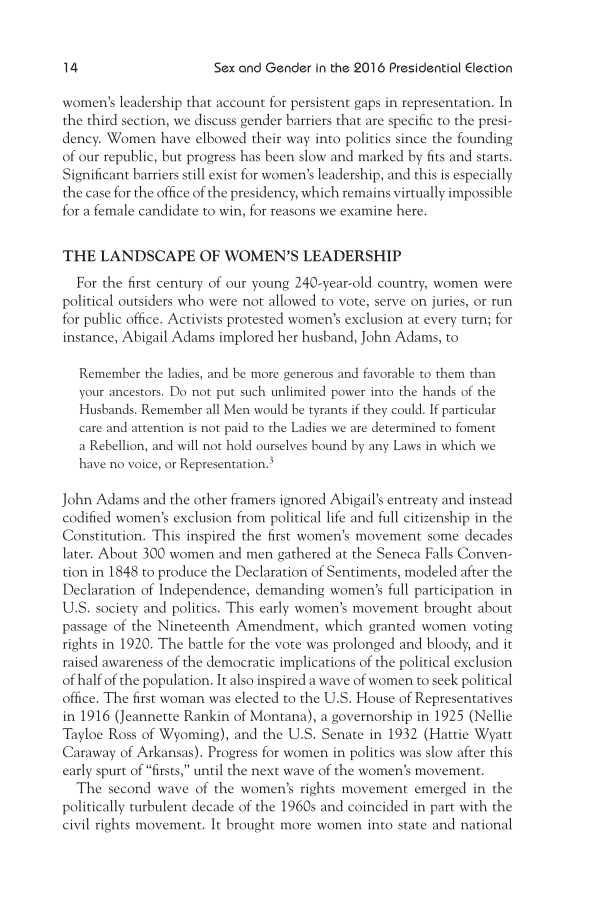Sex and Gender in the 2016 Presidential Election 14 women’s leadership that account for persistent gaps in representation. In the third section, we discuss gender barriers that are specific to the presi- dency. Women have elbowed their way into politics since the founding of our republic, but progress has been slow and marked by fits and starts. Significant barriers still exist for women’s leadership, and this is especially the case for the office of the presidency, which remains virtually impossible for a female candidate to win, for reasons we examine here. THE LANDSCAPE OF WOMEN’S LEADERSHIP For the first century of our young 240-year-old country, women were political outsiders who were not allowed to vote, serve on juries, or run for public office. Activists protested women’s exclusion at every turn for instance, Abigail Adams implored her husband, John Adams, to Remember the ladies, and be more generous and favorable to them than your ancestors. Do not put such unlimited power into the hands of the Husbands. Remember all Men would be tyrants if they could. If particular care and attention is not paid to the Ladies we are determined to foment a Rebellion, and will not hold ourselves bound by any Laws in which we have no voice, or Representation.3 John Adams and the other framers ignored Abigail’s entreaty and instead codified women’s exclusion from political life and full citizenship in the Constitution. This inspired the first women’s movement some decades later. About 300 women and men gathered at the Seneca Falls Conven- tion in 1848 to produce the Declaration of Sentiments, modeled after the Declaration of Independence, demanding women’s full participation in U.S. society and politics. This early women’s movement brought about passage of the Nineteenth Amendment, which granted women voting rights in 1920. The battle for the vote was prolonged and bloody, and it raised awareness of the democratic implications of the political exclusion of half of the population. It also inspired a wave of women to seek political office. The first woman was elected to the U.S. House of Representatives in 1916 (Jeannette Rankin of Montana), a governorship in 1925 (Nellie Tayloe Ross of Wyoming), and the U.S. Senate in 1932 (Hattie Wyatt Caraway of Arkansas). Progress for women in politics was slow after this early spurt of “firsts,” until the next wave of the women’s movement. The second wave of the women’s rights movement emerged in the politically turbulent decade of the 1960s and coincided in part with the civil rights movement. It brought more women into state and national
Document Details My Account Print multiple pages
Print
You have printed 0 times in the last 24 hours.
Your print count will reset on at .
You may print 0 more time(s) before then.
You may print a maximum of 0 pages at a time.

































































































































































































































